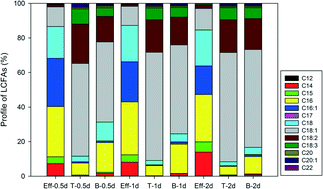Impact of microbial activities and hydraulic retention time on the production and profile of long chain fatty acids in grease interceptors: a laboratory study†
Abstract
Fat, oil and grease (FOG) deposits are a major cause of sanitary sewer overflows (SSOs), and calcium salts of long chain fatty acids (LCFAs) have recently been identified as key components of FOG deposits in sewer systems. Since grease interceptors (GIs) are commonly used to prevent sewer FOG deposits, this study aims to investigate how microbial activities and hydraulic retention time (HRT) of laboratory GI reactors affect the production and profile of LCFAs. The GI reactors with microbial activities exhibited five times higher total LCFAs than the control reactors where microbial activities were inhibited, and a significant positive correlation was observed between microbial activities and total LCFA concentration in the reactor effluent. However, HRT did not exhibit a consistent impact on microbial activities, COD, and total LCFA concentrations in the GI reactor effluent, which was likely caused by the stratified operational mode of the GI reactors. A significantly higher concentration of LCFAs was detected within the GI reactors than in the effluent, corresponding to the stratification of LCFAs within the GI reactors. High similarity of LCFA profile was observed between the GI effluent and real FOG deposits, while the LCFAs retained within the GI reactors, which contained more unsaturated LCFAs, showed different profiles than that in the GI effluent. Together, our data indicate that microbial activities in GIs can significantly impact the quantity and profile of LCFAs, which should be taken into consideration in the GI design and operation in order to reduce the formation of FOG deposits in sewer systems.


 Please wait while we load your content...
Please wait while we load your content...